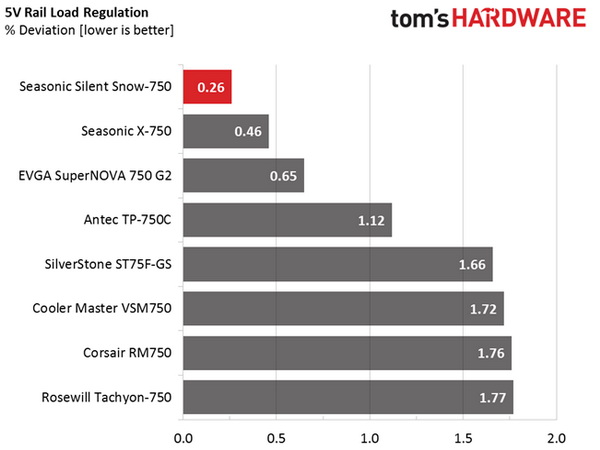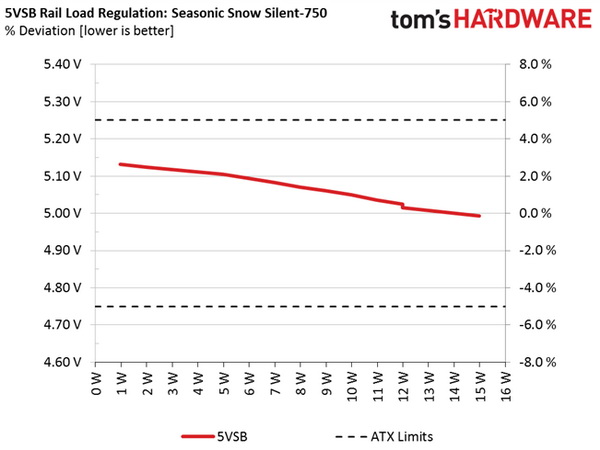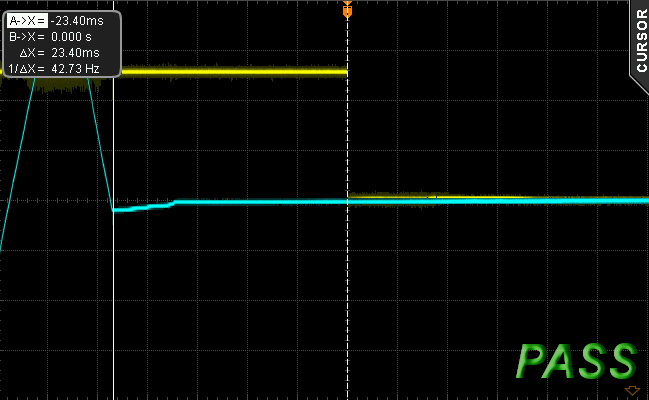Seasonic Snow Silent 750W Power Supply Review
Recently, Seasonic introduced a new 750W Snow Silent unit, featuring Platinum-rated efficiency, fully modular cabling and semi-passive operation.
Why you can trust Tom's Hardware
Load Regulation, Hold-Up Time And Inrush Current
To learn more about our PSU tests and methodology, please check out How We Test Power Supply Units.
Primary Rails And 5VSB Load Regulation
Load Regulation testing is detailed here.








Hold-Up Time
Our hold-up time tests are described in detail here.


The hold-up time was significantly higher than the minimum time that the ATX spec demands.
Inrush Current
For details on our inrush current testing, please click here.


With 115VAC input, the registered inrush current was pretty low, but was higher than average with 230VAC, especially for a 750W unit.
Load Regulation And Efficiency Measurements
The first set of tests reveals the stability of the voltage rails and the PSU's efficiency. The applied load equals (approximately) 10 to 110 percent of the maximum load the supply can handle, in increments of 10 percentage points.
Get Tom's Hardware's best news and in-depth reviews, straight to your inbox.
We conducted two additional tests. During the first, we stressed the two minor rails (5V and 3.3V) with a high load, while the load at +12V was only 0.10A. This test reveals whether a PSU is Haswell-ready or not. In the second test, we determined the maximum load the +12V rail could handle with minimal load on the minor rails.
| Test | 12V | 5V | 3.3V | 5VSB | Power(DC/AC) | Efficiency | Fan Speed | Fan Noise | Temp(In/Out) | PF/AC Volts |
|---|---|---|---|---|---|---|---|---|---|---|
| 10% Load | 4.379A | 1.982A | 1.970A | 0.976A | 74.73W | 87.34% | 0 RPM | 0 dB(A) | 43.21 °C | 0.969 |
| 12.144V | 5.033V | 3.347V | 5.105V | 85.56W | 38.86 °C | 115.0V | ||||
| 20% Load | 9.792A | 2.975A | 2.955A | 1.175A | 149.71W | 90.67% | 0 RPM | 0 dB(A) | 44.06 °C | 0.994 |
| 12.139V | 5.031V | 3.347V | 5.094V | 165.11W | 39.56 °C | 115.0V | ||||
| 30% Load | 15.562A | 3.475A | 3.464A | 1.374A | 224.88W | 90.93% | 534 RPM | 27.9 dB(A) | 38.19 °C | 0.987 |
| 12.134V | 5.030V | 3.345V | 5.083V | 247.30W | 44.02 °C | 115.0V | ||||
| 40% Load | 21.316A | 3.972A | 3.944A | 1.575A | 299.70W | 91.89% | 534 RPM | 27.9 dB(A) | 39.29 °C | 0.989 |
| 12.129V | 5.029V | 3.345V | 5.071V | 326.14W | 45.24 °C | 115.0V | ||||
| 50% Load | 26.742A | 4.969A | 4.931A | 1.775A | 374.70W | 91.84% | 670 RPM | 31.2 dB(A) | 39.91 °C | 0.992 |
| 12.125V | 5.028V | 3.344V | 5.060V | 407.98W | 46.16 °C | 115.0V | ||||
| 60% Load | 32.163A | 5.964A | 5.920A | 1.980A | 449.58W | 91.55% | 1125 RPM | 36.9 dB(A) | 41.74 °C | 0.993 |
| 12.120V | 5.026V | 3.344V | 5.049V | 491.10W | 48.29 °C | 115.0V | ||||
| 70% Load | 37.601A | 6.967A | 6.908A | 2.179A | 524.61W | 91.07% | 1644 RPM | 45.7 dB(A) | 42.11 °C | 0.994 |
| 12.115V | 5.025V | 3.343V | 5.036V | 576.07W | 48.95 °C | 115.0V | ||||
| 80% Load | 43.028A | 7.959A | 7.898A | 2.385A | 599.47W | 90.51% | 1974 RPM | 49.5 dB(A) | 43.33 °C | 0.995 |
| 12.111V | 5.024V | 3.341V | 5.024V | 662.33W | 50.31 °C | 114.9V | ||||
| 90% Load | 48.898A | 8.465A | 8.410A | 2.391A | 674.56W | 89.97% | 2130 RPM | 52.2 dB(A) | 44.27 °C | 0.996 |
| 12.106V | 5.023V | 3.340V | 5.015V | 749.75W | 51.51 °C | 115.0V | ||||
| 100% Load | 54.515A | 8.964A | 8.890A | 3.000A | 749.42W | 89.27% | 2130 RPM | 52.2 dB(A) | 44.90 °C | 0.996 |
| 12.102V | 5.021V | 3.340V | 4.993V | 839.50W | 52.43 °C | 114.9V | ||||
| 110% Load | 60.724A | 8.965A | 8.893A | 3.005A | 824.26W | 88.80% | 2130 RPM | 52.2 dB(A) | 44.93 °C | 0.996 |
| 12.097V | 5.020V | 3.339V | 4.987V | 928.20W | 52.54 °C | 114.9V | ||||
| Cross-Load 1 | 0.101A | 15.013A | 15.005A | 0.004A | 126.95W | 84.47% | 984 RPM | 35.5 dB(A) | 42.19 °C | 0.989 |
| 12.141V | 5.027V | 3.348V | 5.105V | 150.29W | 48.38 °C | 115.0V | ||||
| Cross-Load 2 | 61.944A | 1.002A | 1.003A | 1.002A | 762.66W | 89.89% | 2130 RPM | 52.2 dB(A) | 44.64 °C | 0.996 |
| 12.095V | 5.024V | 3.344V | 5.050V | 848.40W | 52.02 °C | 114.9V |
Load regulation is superb on all rails, and this kind of performance can put even digitally controlled PSUs to shame. Seasonic does a great job, showing that the company has mastered the use of analog circuits. We’ll expect even more from it once the company starts using digital circuits. In addition, the PSU is very quiet up to the 50 percent load test. The fan started to output increased noise from the 70 percent load, exceeding 50 dB(A) under very high loads. However, in order to make the fan spin at its full speed, we had to push the PSU hard, with a 45 °C ambient temperature inside the hot box.
In the efficiency section, the PSU cleared 80 PLUS' Platinum requirements with 20 percent of its max-rated capacity load and with full load. However, in the 50 percent load test, it didn't manage to surpass the 92 percent efficiency requirement. Nonetheless, the 80 PLUS certification tests are conducted at a much lower ambient. The lower the temperature, the higher the efficiency. Therefore, under normal conditions, this unit will have no problem meeting all of 80 PLUS' Platinum requirements.
Current page: Load Regulation, Hold-Up Time And Inrush Current
Prev Page A Look Inside And Component Analysis Next Page Efficiency, Temperature And Noise
Aris Mpitziopoulos is a contributing editor at Tom's Hardware, covering PSUs.